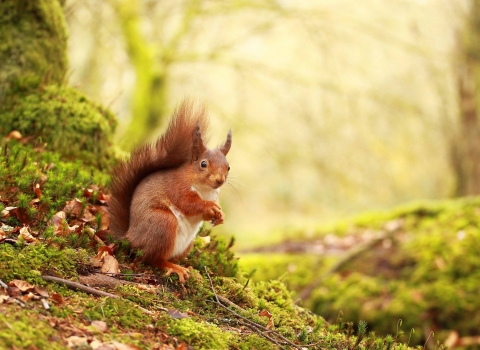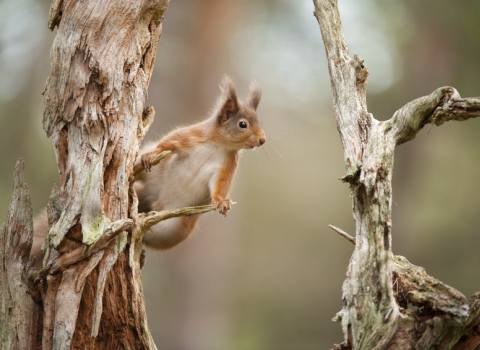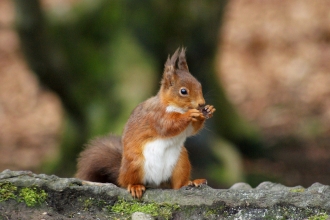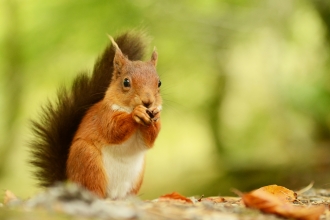Why do red squirrels need protecting?
The red squirrel is one of our most iconic, much-loved mammals immortalised as 'squirrel nutkin' by Beatrix Potter. Seeing a flash of red for the first time is a very special moment and something that everybody should experience.
Red squirrels also play a vital role in regenerating our woodlands, burying nuts and seeds which grow into future trees that sustain a host of native woodland dwellers, such as pine martens and jays.
Sadly, these charismatic creatures are under threat from the invasive non-native grey squirrel which was introduced from North America by the Victorians. Competition from the more robust grey squirrel for food and shelter, and infection by the deadly Squirrelpox virus – which greys transmit to reds - has been the main factor in the red squirrel’s decline. Habitat loss and fragmentation have also played a part.
Ireland is now a stronghold for the species as they are slowly recovering after years of decline. With your help, we can ensure our precious red squirrels don't disappear again.
How is Ulster Wildlife helping?
We are working with landowners, local communities and local red squirrel groups across Northern Ireland to help red squirrels thrive by managing red squirrel habitat, undertaking education and awareness activities, monitoring squirrel populations, and carrying out targeted control of grey squirrels.
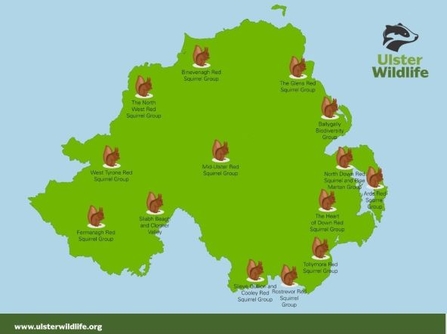
Red Squirrel Groups across NI - 2022
Frequently Asked Questions
Why can't red and grey squirrels live together?
It is widely established that the introduction of the invasive non-native grey squirrel from North America to Ireland in 1911 has led to the drastic decline in red squirrels - see map. Grey squirrels compete more successfully than red squirrels for food and habitat. They are larger and more robust and can digest seeds with high tannin content, such as acorns, more efficiently. This forces red squirrels into other areas where they can find it more difficult to survive. And, over time, grey squirrels ultimately replace red squirrels. As a result, grey squirrels are regarded as 100 of the World’s Worst Invasive Alien Species.
What is squirrelpox and what can be done about it?
This lethal virus, carried by grey squirrels without causing them harm, is fatal to red squirrels and once infected, red squirrels often suffer a slow and painful death. The virus produces scabs and sores in and around the eyes, nose, mouth, feet, ears and genitalia. The infected squirrel is very quickly unable to see or to feed properly and rapidly becomes dehydrated and malnourished. The disease is highly virulent in red squirrels and kills within 15 days of infection.
A vaccine against squirrelpox is in development but it could be many years before this is available in the affordable and easily dispensable form necessary to assist red squirrel conservation.
Are grey squirrel numbers controlled humanely?
The killing of any wild animal is always a last resort measure to deal with serious conservation management problems and is only considered where there is strong evidence that this will be effective in achieving conservation objectives.
The methods we have adopted follow the strictest standards for humaneness, according to British and European Guidelines, and any control programmes are carefully targeted and scientifically monitored. Our methods are also supported by the European Scientific Panel on Animal Health and Welfare.
Are there any alternatives to controlling grey squirrels?
No. At this time halting further spread of grey squirrels at strategically targeted points is the only viable option to protect remaining strongholds for red squirrels. Habitat improvements can assist red squirrels to do better than grey squirrels in carefully chosen areas.
Grey squirrel contraception is the subject of research, but this is a long way from being ready for use and may be insufficient on its own.
Visit the UK Squirrel Accord page to find out more about the current status of the research on fertility control.
Do pine martens help control grey squirrels?
Research by the National University of Ireland and Queen’s University Belfast has demonstrated that recovery of Irish pine marten populations can cause populations of grey squirrels to collapse, with a complete recovery of red squirrels following rapidly. We have evidence that this phenomenon is likely to be occurring across large areas of Ireland, including in Co. Fermanagh.
The 2019 All-Ireland Survey demonstrated pine marten range expansion and grey squirrel range contraction in many parts of the island in the past decade. Encouragingly, red squirrels are now reoccupying many formerly deserted sites.
However, we cannot allow the recovery of the pine marten to be the sole prospect for the survival of our red squirrel; in many areas, Pine marten densities remain low and below the levels, which seem to be required to cause grey squirrel population collapse. Moreover, it is considered unlikely that pine marten will ever reach sufficient densities in urban areas to completely remove all grey squirrels.
Pine marten recovery can also create challenges for humans such as using attics for dens or killing poultry. Ulster Wildlife recognises these issues and seeks to provide effective solutions. For more information, visit PineMarten.ie or the DAERA website
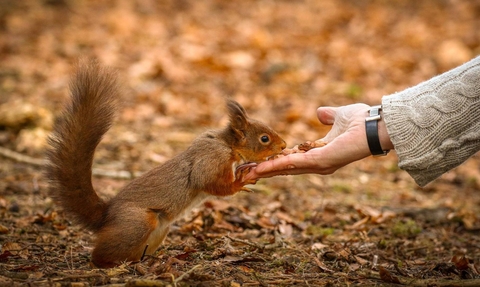
Red squirrel (c) Graham Service
Love red squirrels?
Read our biennial squirrel survey reports
Every two years, thanks to help from dedicated volunteers and partners, we monitor the impact of red squirrel conservation work by surveying red and grey squirrels and pine martens across Northern Ireland. This data, in combination with sightings received from members of the public, is used to track changes in the distribution of these three species and to help target our conservation efforts.

